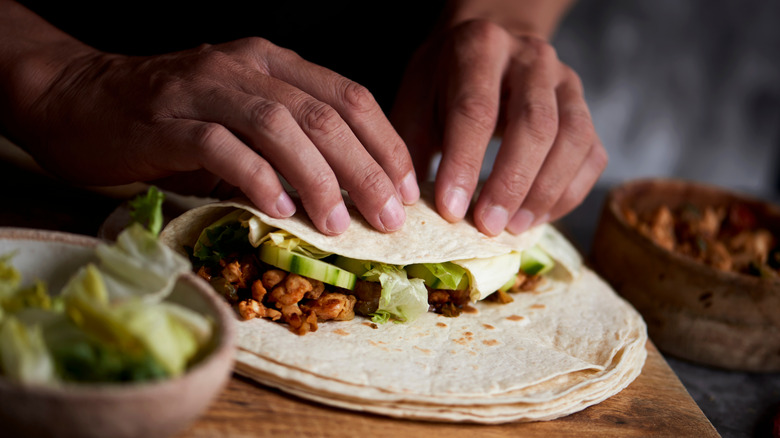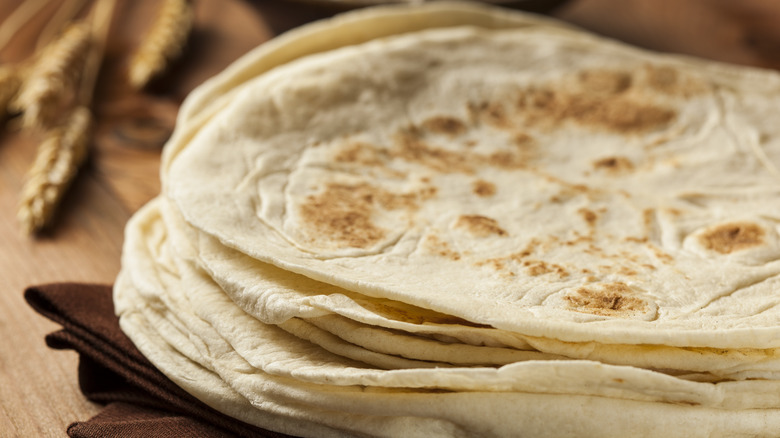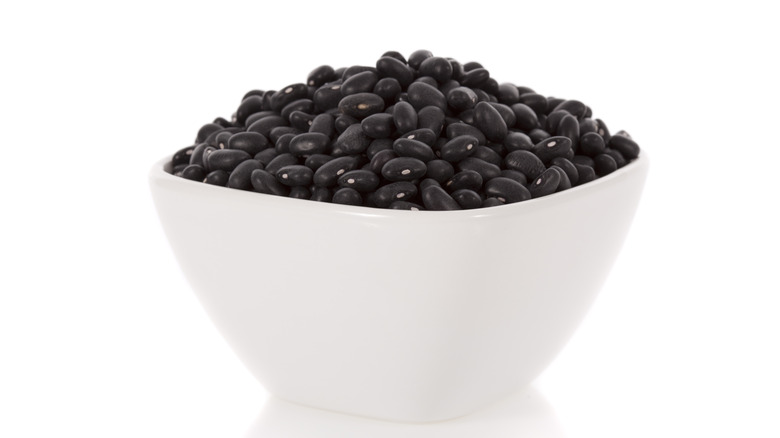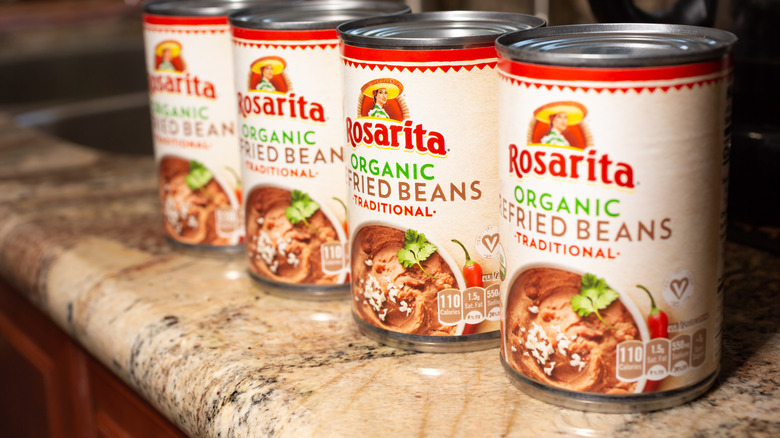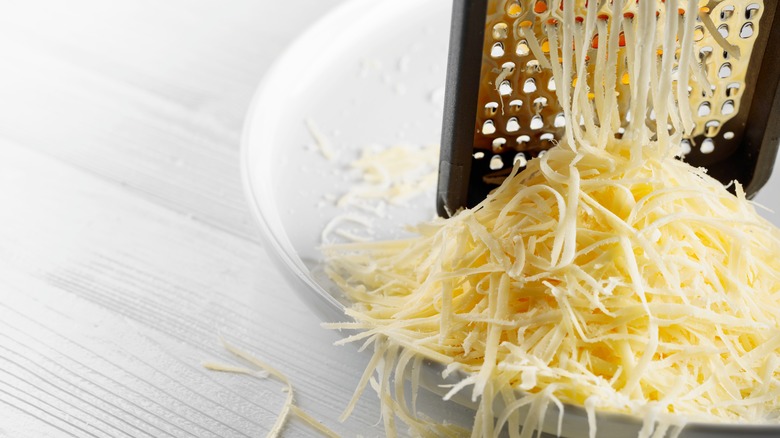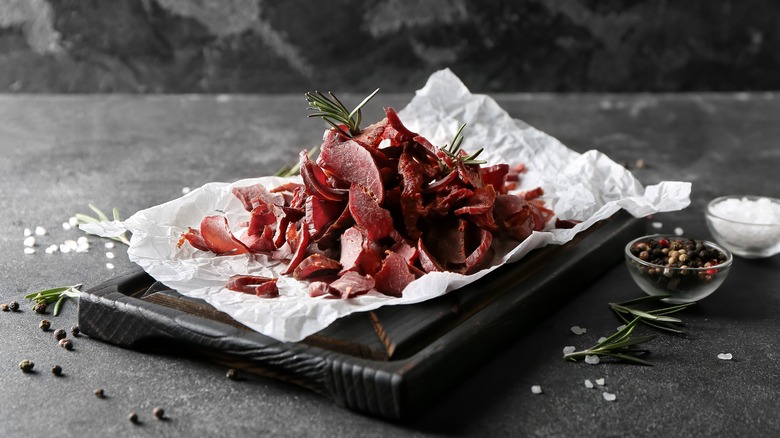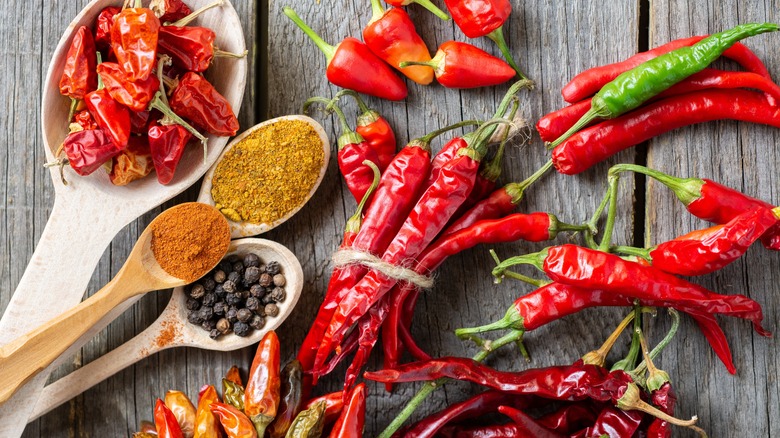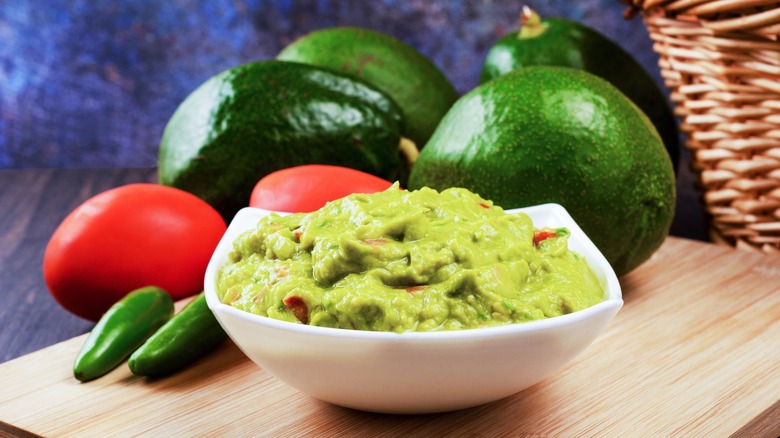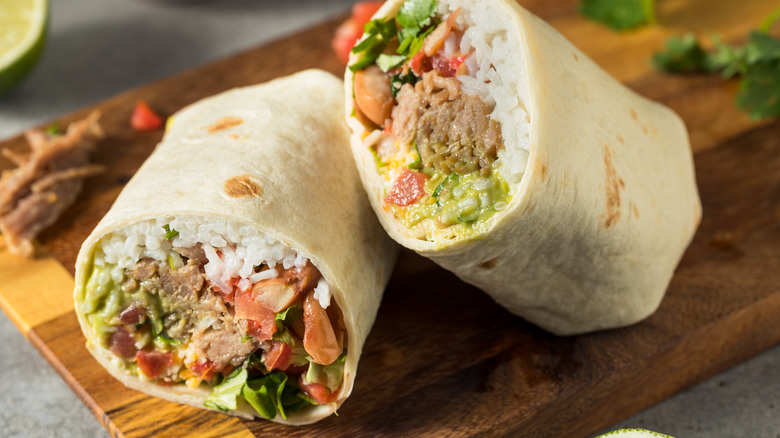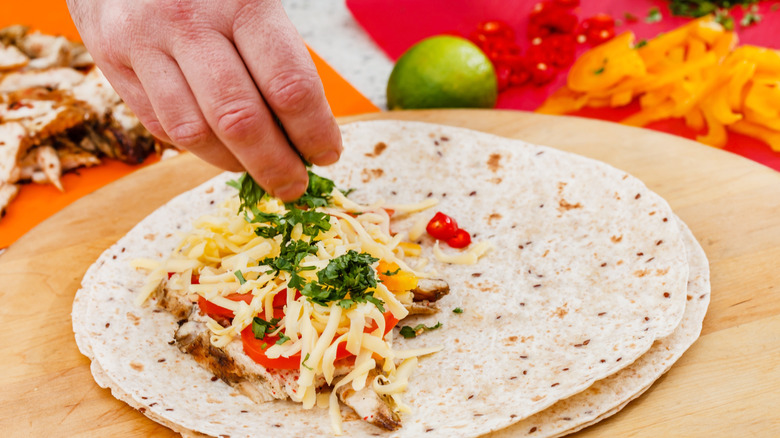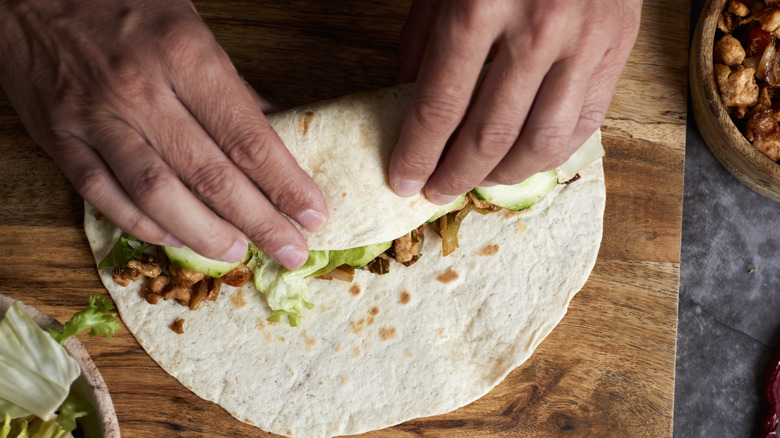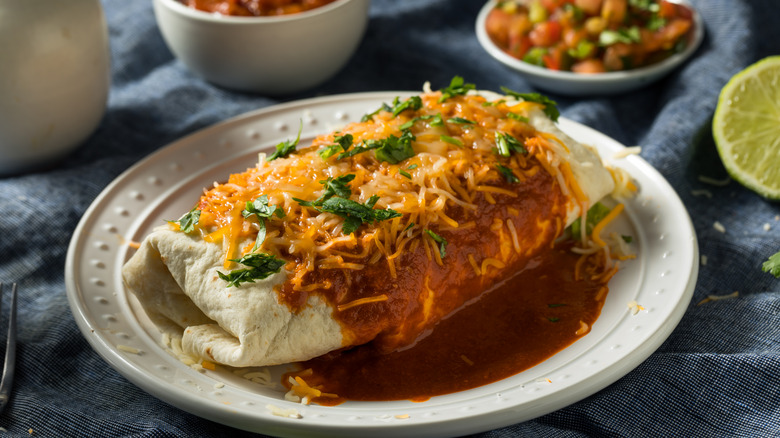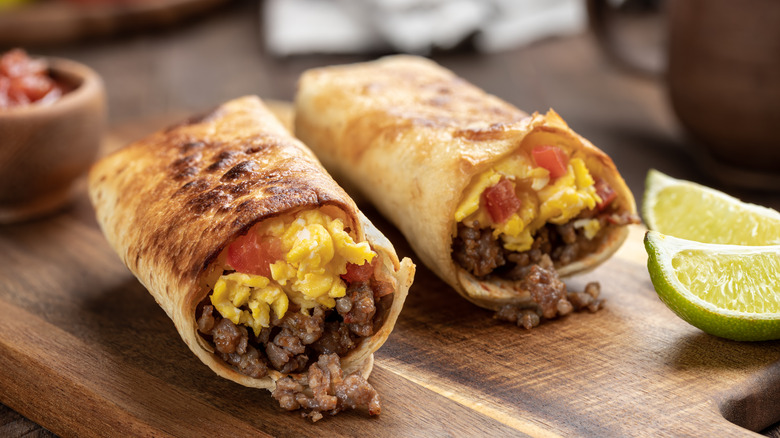14 Tips You Need When Making Burritos
We may receive a commission on purchases made from links.
Whether they're a simple combination of canned refried beans and shredded cheese or an elaborate affair stuffed with a buffet's worth of veggies, rice, and condiments, there's no doubt that burritos are one of our most beloved foods. And though there are plenty of places to get your burrito fix, from national chains to frozen burritos ready in minutes, knowing how to make the best burrito is definitely a skill that will continue to reap rewards.
We reached out to two burrito experts: Mexico-born chef Miguel Escobedo fell in love with burritos when he moved to the Bay Area and discovered the endless culinary approaches. Escobedo and his brother, Victor, opened Papalote Mexican Grill in 1999 and in 2010 they beat Bobby Flay on his show "Throwdown with Bobby Flay" with their triple threat burrito. Today, Escobedo owns the food truck Al Pastor Papi.
Chef Jackie Alpers, meanwhile, learned everything she could about Southwestern cooking while working at El Charro Cafe, one of the oldest family-owned Mexican restaurants in the United States. She went on to write the book "Taste of Tucson," which focuses on the Sonoran cuisine specific to the border of Arizona and Mexico.
We spoke with the chefs to pass along the best tips you need for making better burritos at home.
Start with a great quality tortilla
Starting with the best tortillas you can find is key to making the best burritos. Alpers says to look for packaged burritos that only have a few ingredients — the standard flour tortilla recipe includes just flour, baking powder, shortening, salt, and water. "They shouldn't look too white or too puffy," Alpers notes. "They should be light golden brown in color and have darker brown patches. The stack of tortillas should be slightly different sizes and shapes."
Sonoran-style burritos are wrapped in tortillas made from white Sonoran wheat that's native to the area. "White Sonoran wheat makes the tortillas super stretchy with a rich, pastry-like flavor," says Alpers. If you don't live in the area, you probably won't find these tortillas on your grocery store shelves, but they can be ordered online. These tortillas are the best ones to use when making Tex-Mex-style chimichangas, the deep-fried cousin of the burrito.
Escobedo says the industry standard for restaurant burritos is to use tortillas measuring 12 to 13.5 inches. "Anything smaller starts resembling a large taco and anything bigger just becomes way too much to enjoy in one sitting," he says. If you can't find burritos that big at your local grocery store, just use the largest ones you can find: Many tortilla manufacturers refer to their 10-inch flour tortillas as being 'burrito sized.'"
Decide between black and pinto beans
Anyone who's ever been to a modern-day burrito restaurant like Chipotle Mexican Grill knows that one of the first questions you're asked is: black or pinto? "Bean choice is mainly a preference, but I've found that black beans provide a better canvas for other ingredients to shine," says Escobedo. "I feel like beans in a burrito should not overpower the main ingredient, which is the protein. Here less is more."
Pinto beans have a creamier texture than black beans, making pinto the preferred bean for a refried beans recipe, which is simply beans sauteed with other ingredients and mashed into a paste. But, restaurants often leave them whole in a burrito, and, of course, you can too. If you have time, try cooking dried beans from scratch, so they're the perfect texture and are seasoned just how you like them ... otherwise, the canned versions are an easy shortcut.
From a health standpoint, black and pinto beans' nutrition profiles are similar, both offering up protein, fiber, antioxidants, and other beneficial nutrients. So, if you like one more than another, go ahead and fill your burrito with your favorite bean, served up whole or refried. Just save the kidney beans for making chili.
Doctor up your canned beans
If you don't have the time or the desire to simmer dried beans for hours to make refried beans from scratch, canned beans are a convenient solution, but Alpers suggests eschewing the cans altogether. "I know it's a bit of an oxymoron, but using canned whole pinto beans to make refried beans will still taste a whole lot better than refried beans from a can," she says.
Alper's method for making delicious refried beans: Heat your chosen fat in a large, heavy-bottomed skillet over medium heat. Some people like the smoky flavor of lard, but vegetable oil is just fine; use enough to coat the bottom of the pan. Add the drained and rinsed pinto beans and smash them with the back of a wooden spoon (or a traditional wooden bean masher, called a machacadora) to the desired consistency, while stirring and continuing to fry them. It only takes a few minutes, and the beans are ready as soon as you're done mashing them. Stir in onion flakes, garlic powder, Mexican oregano, salt, and pepper to taste.
If they're too thick, stir in a little broth to reach the desired consistency. If you want very smooth beans, transfer them to a food processor or a blender and puree. If you want to keep your beans whole, drain and rinse the pinto beans, and season them with the same combination of ingredients. These seasonings can also help boost the flavor of canned refried beans.
Don't overthink the cheese
If you love the gooey quality of melted cheese, then cheese is an essential ingredient for your burritos. But when it comes to the type of cheese that goes in your burrito, it's fine to keep it simple.
Chef Escobedo says, "I like good old California Monterey Jack for its slight saltiness and melt-ability." He also sometimes uses mozzarella cheese, which is good for its mild flavor and cheese pull. For special burritos, Escobedo recommends playing with Mexican cheeses like Oaxaca and Cojita, both of which can be found in the Mexican foods refrigerator case at a well-stocked supermarket. Oaxaca cheese is mild with a buttery, salty flavor profile and a stringy consistency similar to mozzarella. Cojita cheese is firm and crumbly and has a slightly funky flavor that gets sharper as it ages. Cotija also doesn't have a stringy quality when it melts, so it's better as a topping on smothered burritos or crumbled inside to add a bit of salty flavor and creamy texture.
Whether you choose Monterey Jack, a Colby-jack blend, cheddar cheese, or any other cheese, it's better to buy a block and grate it yourself. While bags are convenient, pre-grated cheese often contains cellulose, potato starch, or other additives that are mixed in with the cheese to prevent them from caking.
Try a classic Sonoran ingredient
We're all obsessed with the ingredient that Alpers told us is a favorite filling for Sonoran-style burritos: carne seca. This sun-dried shredded beef is a local delicacy in Tucson. "The beef is literally dried in the sun until it becomes jerky, then it's shredded and pan-fried with green chiles, onions, and tomatoes," before being folded into a burrito, explains Alpers.
It sounds like beef jerky, but carne seca (which is Spanish for "dried meat") has a few key differences. The beef is sliced thinner than beef jerky. As Alpers notes, the traditional way to prepare it is by drying it in the sun, and it is drier than jerky. Beef jerky, on the other hand, is made in an oven or a smoker.
At El Charro Cafe, the house-made carne seca is dried in the hot Arizona sun on the restaurant's roof and then cooked with green chile, tomato, and onion. Carne seca is offered in the restaurant's burros and chimichangas, as well as in enchiladas, on a burger, or on its own on a platter with rice, beans, various toppings, and tortillas. Can't make it to Tucson to try a carne seca burrito for yourself? Some beef jerky brands make a carne seca product.
Build heat with each component
If you like things spicy, Alpers says the best way is to "add a little heat to each component." This could mean fresh serrano peppers in your guacamole, a spicy chile con carne for the protein, and jalapeño-spiked salsa mixed in with the beans.
And, of course, serve up the finished burritos with a side of salsa for dipping or drizzling. Alpers says her chiltepin salsa, which appears in her cookbook, is the perfect companion with its blended salsa seasoned with garlic, onion, cilantro, and Mexican oregano. The recipe derives its heat from dried chiltepin chiles, which are native to Southern Arizona. Chiltepins are the only chile pepper species native to the United States and are rarely found in other regions. Their heat level can vary but are typically around 50,000 to 100,000 Scoville units, a heat level that's similar to the habanero. The dried peppers can be ordered online.
If you went too heavy-handed with those spicy seasonings in your burrito, there's a Mexican ingredient that can counter that heat. Mexican crema, which is similar to sour cream in flavor but is milder and has a thinner consistency, can be drizzled over your mouth-scorching burrito to tame that flavor.
Be strategic with how you add the guacamole
Cool and creamy, fresh guacamole will add an element of texture and flavor to any burrito. But, there's a trick to keeping it cool; after all, there's a reason hot guacamole isn't a thing! Alpers suggests layering the guac between two cooler ingredients, such as lettuce and cheese, so it doesn't heat up too much. She also suggests spreading the guacamole the entire length of the burrito, rather than dolloping it onto one end, so you get a little with every bite. Another way to keep guac from getting warm is to serve it on the side for spreading on top of the burrito or to be used as a dip.
We like to make a guacamole recipe with plenty of fresh lime to add an element of tartness to the rich and earthy burrito ingredients. As with the other classic burrito condiment, salsa, guacamole presents a good opportunity to incorporate additional flavors into the burrito, whether it's the sharp, fresh taste of cilantro, the pungent bite of raw onion, or the heat of chile peppers like serrano or habanero.
Prepare it just before serving, unless you know all the tips for keeping guacamole fresh.
Get creative with fillings
When it comes to burritos, there are so many different varieties. There are L.A.-style burritos, which are filled with guisado (a Mexican meat stew), refried beans, salsa, and cheese. There's the burro percherón of Hermosillo, Mexico, a giant version crammed with carne asada, mozzarella, tomato, avocado, and sometimes a creamy ingredient like Mexican crema or mayonnaise. Mission-style burritos are the style Chipotle and other burrito chains emulate.
The sky's the limit when you make your own burrito. Escobedo says he got attention for his burritos at Papalote Mexican Grill when he started creating limited-edition burritos like the Dungeness crab burrito and the Pam the Funkstress burrito that was stuffed with mac and cheese and fried chicken. The chef also got attention with his Mexipino burrito, a combination of Mexican and Filipino cuisines that was filled with authentic Filipino chicken adobo, garlic fried rice, and fresh tomatoes, a burrito that landed him on the show, "Adobo Nation."
As for that burrito that brought down Bobby Flay in the "Throwdown" competition, it included chile-marinated prawns, achiote chicken, and fire-grilled carne asada. Escobedo says, "It was the flavor reaction of the judges alongside Mission District authenticity that put us over the top."
We've seen unique burritos with ingredients as diverse as breaded oysters, kimchi fried rice, tikka masala, yellowfin tuna, or octopus. So, go ahead and clean out the fridge, play with fusion flavors, or come up with some wacky combinations.
Make sure ingredients are balanced
Have you ever taken a first bite of a handheld burrito and gotten a big mouthful of sour cream and not much else ... only to get to the last few bites that are all rice? Building a burrito is an art, but it's one that's easy to master. "All of the ingredients need to be laid down the middle of the burrito in equal proportions," says Alpers. This way, each bite includes all of the ingredients.
Balance is important not just in the burrito itself but in what goes into the burrito. The best burritos strike a balance between all the different flavors and textures: earthy beans, spicy meat, gooey cheese, tangy guacamole, and creamy sour cream.
While one burrito tactic is to get creative with innovative burritos, there's also something to be said for keeping things simple and traditional. "I like the original burrito approach, which is a simple guisado or one meat rolled into a flour tortilla, with a side of some delicious, spicy salsa," says Escobedo. He loves burritos that have traditional ingredients like carne asada, chopped onions, and fresh cilantro. "I'm not a huge fan of lettuce or too many tomatoes in a burrito," he adds.
Perfect the roll
An expertly rolled burrito will hold all those delicious ingredients inside right to the very last bite. It's not hard to do if you know a few tricks. First, a larger tortilla is easier to work with than a smaller one (and, naturally, it also holds more!). Second, a warmed tortilla is more flexible than one straight out of the package, so heat it up either for a few seconds in the microwave or in a dry stainless steel skillet — it only takes a few seconds on each side.
Many burrito chains steam tortillas to heat them, but Escobedo isn't a fan of this: "When you steam flour tortillas, they tend to come out chewy." The heated tortillas can be kept in a tortilla warmer or wrapped in a clean kitchen towel until you're ready to start rolling your burritos. Prepping a bunch of burritos for a party? One trick involves parchment to keep tortillas warm for hours.
Escobedo shares these steps for rolling a burrito, a method he demonstrated for chef Aarón Sánchez in Papalote on an episode of "Taco Trip": All the ingredients should be placed firmly in the middle of a large flour tortilla. Fold the sides over the ingredients, and press down a little to spread the ingredients evenly. When the side folds are parallel, bring the side of the tortilla over the top, tuck it in, and roll the burrito tightly away from you.
Try grilling or smothering your burrito
To truly take a burrito to the next level, opt for a finishing touch. While Escobedo likes to toast his tortillas well on a grill before rolling, others are a fan of grilling the whole burrito, a trend popularized by a Taco Bell hack in which the restaurant's cheesy bean and rice burritos take a turn under the grill until the tortilla gets crisp (you can even ask for a double grilled burrito for an extra crispy exterior). You get a similar effect at home by heating a lightly oiled skillet and cooking the burrito until it's lightly toasted on either side. To up the game even more, sprinkle a little cheese in the pan just before you add the burrito, letting the cheese stick to the burrito and crisp up.
Another option is to smother a burrito — also called a wet burrito — in enchilada sauce and a generous sprinkling of cheese, then broiling it until the cheese melts. Escobedo adds, "I also love a mole-smothered burrito as well." Any of these methods will likely make it necessary to eat your burrito with a knife and fork, rather than your hands, but they'll be well worth the extra dishes.
Don't overlook breakfast burritos
In Alpers' cookbook, "Taste of Tucson," breakfast burritos have their own section, mainly because breakfast burros are the meal of choice after a long night of barhopping. "The signs from locally owned 24-hour drive-through joints dot the night sky all over Tucson, serving as beacons for the giant burros available inside, that are approximately three times larger than a standard sized burrito (a burrito is a little burro)," she says.
Alpers' favorite breakfast burrito has scrambled eggs, whole or refried pinto beans, melted cheese, and lots of salsa. Other popular ingredients in breakfast burritos include fried potatoes or meat, such as cooked bacon or sausage.
Alpers describes her method for making the perfect breakfast burrito: Warm the largest tortilla you can find on a large skillet or in the microwave for five to 10 seconds. Lay the tortilla on a clean, flat work surface, and fold up the bottom third of the tortilla. Scramble some eggs. Layer the ingredients on the folded area closest to the middle of the tortilla, starting with the cheese, then the eggs, and a layer of beans and any other fillings. Roll the base and filling one turn so the fold is at the widest part of the tortilla, then fold the two shorter ends in and roll again to enclose the filling fully.
Says Alpers, "I bite the end of the burrito first, then pour salsa into the open hole, adding in more as I progress."
